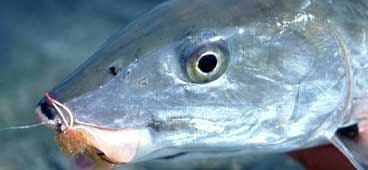
Bonefish BIG
VIRGINIA KEY, FL (November 30, 2004) – If you’re looking for bonefish **from **Miami **down to the **Marquesas Islands, you have about 300,000 to choose from. That’s the outcome of Rosenstiel School’s second annual Florida Keys bonefish census which produced comparable results to its first, indicating that its mechanism for estimating bonefish numbers is probably an accurate one.
“You shouldn’t see large changes in numbers from year to year, if you’re doing your census accurately,” said Dr. Jerry Ault, Rosenstiel School associate professor of marine biology and fisheries. “Unless there’s some reason to expect an abrupt population change, the estimated population number should remain relatively stable. The good news here is that we are building a great, seemingly accurate baseline to determine long-term trends in the abundance of this precious resource, and we didn’t have that before now.”
Fifty-five boats set out on Oct. 26 to cover 19 clearly defined zones and visually and relatively methodically, count bonefish throughout the day. The volunteers, who ranged from fisherman to scientists and graduate students, covered 1,721 square miles of popular bonefish territory, which ultimately resulted in a population estimate this year of 304,805 bonefish (+/- 44,567 for a 14.6 percent coefficient of variation) or 177.11 bonefish per square mile.
Last year, only 40 boats went out, covering the very same zones at the same time of year and for the same amount of time. The result, however, was quite comparable: 287,662 estimated bonefish in this same area – a difference of only 17,143 fish.
“While the number is slightly higher this year, that change is not statistically significant and probably due to the nearly 40 percent increase we had in boats that surveyed the area,” Ault said. “Despite this great increase in survey boats, we still had comparable counts which indicates that we are on the right track and have an effective process.”
Bonefish are valuable for two reasons. Because of their large size, bonefish obviously rely on smaller creatures in the ecosystem whose populations aren’t as easy to assess. Bonefish are fairly easy to count on the flats and can be seen as an indicator of the overall ecosystem’s general health-researchers will observe changes here much sooner than within a smaller creature whose numbers are in the millions.
For South Florida, bonefish are valuable for another reason. They bring in a significant amount of tourism. Bonefish sport fishing contributes approximately $1.0 billion annually to the Florida economy, making sport fishing more valuable than commercial fishing in today’s market.
“This estimate of the ‘visible’ population makes each bonefish in the water worth about $3,500 per year to the industry, and about $70,000 per fish over its lifetime,” Dr. Ault said.
Professional guides from the Florida Keys Fishing Guides Association, the Lower Keys Fishing Guides Association and the Key Largo Fishing Guides Association played an integral role in the census’ success by providing boats and manpower.
For more information:
Ivy F. Kupec
Rosenstiel School of Marine and Atmospheric Science
4600 Rickenbacker Causeway
Key Biscayne, Fla. 33149
305.421.4704
http://www.rsmas.miami.edu









